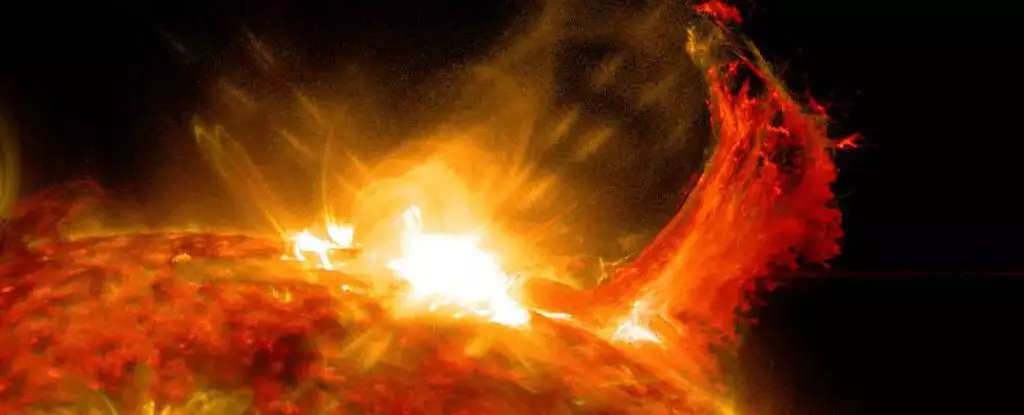The Sun, the center of our solar system, appears as a constant source of light and warmth, but beneath its serene exterior lies a tumultuous environment teeming with chaotic activity. From unpredictable convection currents to unpredictable magnetic disruptions, the Sun’s surface is a cauldron of energy. While most solar activities are harmless, there exists a more dangerous phenomenon—the solar superflare. Recent research suggests that these powerful eruptions may occur more frequently than previously thought, and humanity has much to learn about the risks they pose.
Solar superflares are immense bursts of energy that can impact planets in a myriad of ways. Unlike regular solar flares, which happen with relative frequency, superflares possess the potential for severe consequences. New analyses examining over 56,000 stars similar to our Sun estimate that our star may unleash a superflare approximately once every century. Recognizing the difference between standard solar activities and the rare, catastrophic superflare is essential for understanding how to prepare for severe solar events.
Astronomical records hint at past solar events that have wreaked havoc on Earth. For instance, the Carrington Event in 1859, while impressive in its own right, was a mere shadow of what a superflare can unleash. Such historical data underscores the peril posed by these powerful bursts, often accompanied by coronal mass ejections (CMEs) that can disrupt electromagnetic systems.
The mechanisms that drive the frequency of superflares from the Sun remain largely elusive. Researchers scrutinized a diverse array of Sun-like stars, attempting to glean information about their activity levels. One major hurdle in this quest is the difficulty in measuring the rotation rates of these stars, as rotation is closely tied to flare activity. Recent findings indicating that fantastically bright and temperate stars with slower rotations may be more prone to flaring challenge previous assumptions about star activity habits.
By studying a broad sample of over 56,000 Sun-like stars, researchers were able to establish a superflare occurrence rate estimated at around 100 years. This alarming figure indicates that while the Sun’s activity may be less frequent than once feared, its sporadic eruptions could carry significant implications. Notably, young stars tend to have higher activity levels, implying that our aging Solar System might hold a finite number of potentially catastrophic solar events in its remaining lifespan.
To better contextualize the significance of solar superflares, it is essential to delve into Earth’s history and the effects of past solar activity. Tree ring analysis reveals that several intense geomagnetic storms—designated as Miyake Events—have occurred in the last 15,000 years. The implications of these findings suggest a more frequent recurrence of solar threats than one might expect, with the last known event traced back to 774 CE.
These historical records not only serve as a warning but also connect the current understanding of solar behavior with mentioned future consequences. Besides the might of the Carrington Event, scientists have uncovered evidence of even larger storms that could disrupt modern infrastructure and technology critically.
While scientists do possess a foundational understanding of solar flares, the unpredictable nature of solar activity prevents them from guaranteeing accurate forecasts of superflare occurrences. Given the far-reaching effects that these events can have on Earth—including the disruption of power grids, telecommunications, and satellite infrastructure—there is a growing consensus on the need for heightened awareness and preparation.
One significant concern is that not all solar flares are accompanied by coronal mass ejections, creating uncertainties in assessing potential threats accurately. Therefore, further innovation in detection and analysis strategies is necessary to safeguard humanity against inevitable solar phenomena. In the realm of science and technology, understanding the Sun’s tendencies—along with enhancing forecasting measures—can provide us with the necessary tools to respond more effectively to solar challenges.
As research into solar superflares continues to evolve, the need for collaboration between astrophysicists and solar researchers grows ever more critical. The intricate relationship between solar activity and planetary consequences underscores the importance of seeking out a more profound understanding of these celestial phenomena. It is clear that the Sun, while a giver of life on Earth, also harbors unpredictable dangers that could challenge humanity’s technological infrastructures in the years ahead.
The study of solar superflares offers a window into the dynamic nature of our own star and the potential threats it poses to life on Earth. Through vigilance and further research, we can hope to unlock more about the enigmatic behaviors of our Sun and devise methods to prepare for the unseen challenges that lie ahead.



Leave a Reply